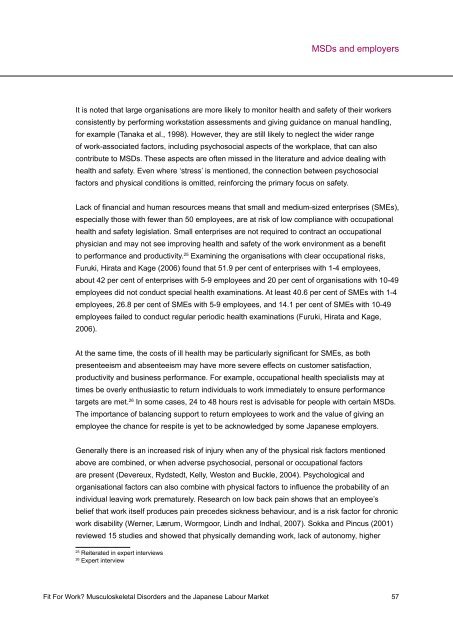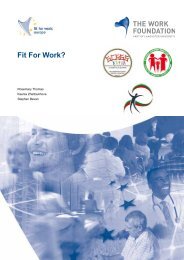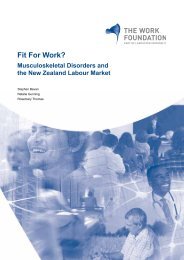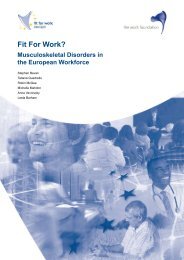English version - Fit for Work Europe
English version - Fit for Work Europe
English version - Fit for Work Europe
Create successful ePaper yourself
Turn your PDF publications into a flip-book with our unique Google optimized e-Paper software.
It is noted that large organisations are more likely to monitor health and safety of their workers<br />
consistently by per<strong>for</strong>ming workstation assessments and giving guidance on manual handling,<br />
<strong>for</strong> example (Tanaka et al., 1998). However, they are still likely to neglect the wider range<br />
of work-associated factors, including psychosocial aspects of the workplace, that can also<br />
contribute to MSDs. These aspects are often missed in the literature and advice dealing with<br />
health and safety. Even where ‘stress’ is mentioned, the connection between psychosocial<br />
factors and physical conditions is omitted, rein<strong>for</strong>cing the primary focus on safety.<br />
Lack of financial and human resources means that small and medium-sized enterprises (SMEs),<br />
especially those with fewer than 50 employees, are at risk of low compliance with occupational<br />
health and safety legislation. Small enterprises are not required to contract an occupational<br />
physician and may not see improving health and safety of the work environment as a benefit<br />
to per<strong>for</strong>mance and productivity. 25 Examining the organisations with clear occupational risks,<br />
Furuki, Hirata and Kage (2006) found that 51.9 per cent of enterprises with 1-4 employees,<br />
about 42 per cent of enterprises with 5-9 employees and 20 per cent of organisations with 10-49<br />
employees did not conduct special health examinations. At least 40.6 per cent of SMEs with 1-4<br />
employees, 26.8 per cent of SMEs with 5-9 employees, and 14.1 per cent of SMEs with 10-49<br />
employees failed to conduct regular periodic health examinations (Furuki, Hirata and Kage,<br />
2006).<br />
At the same time, the costs of ill health may be particularly significant <strong>for</strong> SMEs, as both<br />
presenteeism and absenteeism may have more severe effects on customer satisfaction,<br />
productivity and business per<strong>for</strong>mance. For example, occupational health specialists may at<br />
times be overly enthusiastic to return individuals to work immediately to ensure per<strong>for</strong>mance<br />
targets are met. 26 In some cases, 24 to 48 hours rest is advisable <strong>for</strong> people with certain MSDs.<br />
The importance of balancing support to return employees to work and the value of giving an<br />
employee the chance <strong>for</strong> respite is yet to be acknowledged by some Japanese employers.<br />
Generally there is an increased risk of injury when any of the physical risk factors mentioned<br />
above are combined, or when adverse psychosocial, personal or occupational factors<br />
are present (Devereux, Rydstedt, Kelly, Weston and Buckle, 2004). Psychological and<br />
organisational factors can also combine with physical factors to influence the probability of an<br />
individual leaving work prematurely. Research on low back pain shows that an employee’s<br />
belief that work itself produces pain precedes sickness behaviour, and is a risk factor <strong>for</strong> chronic<br />
work disability (Werner, Lærum, Wormgoor, Lindh and Indhal, 2007). Sokka and Pincus (2001)<br />
reviewed 15 studies and showed that physically demanding work, lack of autonomy, higher<br />
25 Reiterated in expert interviews<br />
26 Expert interview<br />
MSDs and employers<br />
<strong>Fit</strong> For <strong>Work</strong>? Musculoskeletal Disorders and the Japanese Labour Market 57







